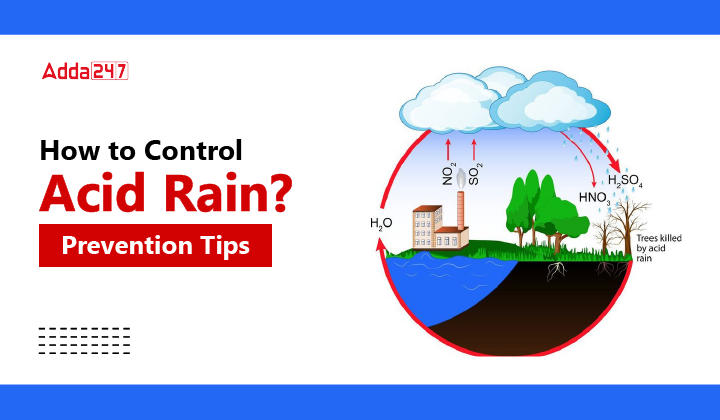Table of Contents
Pollution has emerged as a global issue. There are various factors responsible for this disaster that poses problems for both biotic and abiotic environment. Pollution is the root cause of several issues like global warming, wildlife destruction and other disasters. One of which is acid rain. Acid rain is a horrific phenomenon affecting nearly everything including Plants, soil, trees and buildings. In this article we will understand the meaning, chemical composition, causes and ways to prevent the environment from it.
What is Acid Rain?
The term acid rain was coined in 1852 by Scottish chemist Robert Angus Smith. The water droplets with high sulphur and nitrogen content in the atmosphere are called acid rain.
Acid rain is caused by a chemical reaction that starts when toxic compounds are released into the air. These substances can rise high up in the atmosphere, where they get combined and reacted with water, oxygen, and other chemicals to form an acidic content known as acid rain. Sulfur dioxide and nitrogen oxides get dissolved in water and can be carried very far by the wind. As a result, the two compounds can travel long distances where and become part of the rain, sleet, snow, and fog that we experience on certain days.
Acid Rain Chemical Reactions
Sulphur dioxide and nitrogen dioxide undergo oxidation, and then they react with water resulting in the formation of sulphuric acid and nitric acid, respectively. The following reaction will clarify the acid formation reaction:
2SO2 (g) + O2 (g) + 2H2O (l) → 2H2SO4 (aq)
4NO2 (g) + O2 (g) + 2H2O (l) → 4HNO3 (aq)
The normal acidity of rainwater is 5.6 as per the pH scale. But the pH of acid rain is further lowered to 2.4 making it disastrous for the environment.
Causes of Acid Rain
Normal precipitation—such as rain, sleet, or snow—reacts with alkaline chemicals, or non-acidic materials, that can be found in air, soils, bedrock, lakes, and streams. But some chemical reactions can worsen the situation and make the water content in the atmosphere too acidic. It causes damage to crops, trees, lakes, rivers, and animals. The following are the two major causes contributing to acidic rain:
Natural causes: Natural causes are the natural reasons responsible for the occurrence of acid rain. These include the sources like volcanic eruptions, biological processes and lighting. These are not more potent for changing the chemical composition of the environment.
Anthropogenic causes: These are non-natural reasons resulting in acidic rain. These are also known as man-made causes. Over the past few decades, humans are responsible for releasing different chemicals into the air that have changed the mix of gases in the atmosphere. Burning fossil fuels and the exhaust from cars, trucks, and buses release nitrogen oxides and sulfur dioxide into the air.
What are the Effects of Acid Rain
Acid rain affects not only the biotic environment but also the abiotic environment. This includes:
- The adverse effect of Acid Rain can be seen on plants and trees causing the yellowing of leaf tissue known as chlorosis,
- It results in toxification of soil It takes away soil nutrients causing stunted growth. Block stomatal pores of leaves.
- It causes damage to fish and aquatic animals.
- Extensive damage to buildings, structural materials of marble, limestone, slate etc
Prevention tips for Acid Rain
In order to prevent acid rain from forming. One can do efforts on an individual and group basis to prevent the disastrous happening to take place. Below are some prevention tips for acid rain to occur:
- As a common saying, prevention is better than cure. Hence, there is a need to check the emission of oxides of nitrogen and sulphur.
- We need to act responsibly and let ourselves/ others be aware of the harmful effects they cause release of nitrogen and sulphur compound wastes.
- Use cleaner sources of energy and renewable sources of energy.
- Use clean combustion and pollution control equipment
- Formulate policy framework to check on the emission of sulphur and nitrogen oxides.
Conclusion
Hence, acid rain can cause harmful consequences resulting in the destruction of the atmosphere around us. There are many real-life examples like in India the white marble of The Taj Mahal has turned yellowish just because of the harmful presence of toxic substances in the atmosphere. It has become the need of the hour to start making efforts to reduce and mark check on the emission of such substances to avoid the incidence of acid rain.



 UP TGT Sanskrit Syllabus and Exam Patter...
UP TGT Sanskrit Syllabus and Exam Patter...
 UGC NET Study Notes for Paper 1, Downloa...
UGC NET Study Notes for Paper 1, Downloa...
 Bloom Taxonomy, Purpose, Domains, Exampl...
Bloom Taxonomy, Purpose, Domains, Exampl...




